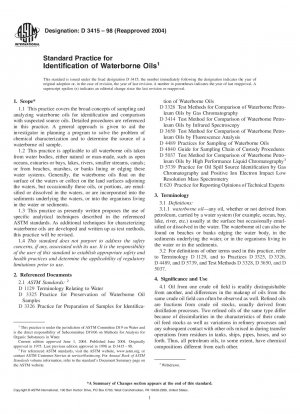ASTM D3415-98(2004)
Standard Practice for Identificaiton of Waterborne Oils
- Standard No.
- ASTM D3415-98(2004)
- Release Date
- 1998
- Published By
- American Society for Testing and Materials (ASTM)
- Status
- Replace By
- ASTM D3415-98(2011)
- Latest
- ASTM D3415-98(2017)
- Scope
Oil from one crude oil field is readily distinguishable from another, and differences in the makeup of oils from the same crude oil field can often be observed as well. Refined oils are fractions from crude oil stocks, usually derived from distillation processes. Two refined oils of the same type differ because of dissimilarities in the characteristics of their crude oil feed stocks as well as variations in refinery processes and any subsequent contact with other oils mixed in during transfer operations from residues in tanks, ships, pipes, hoses, and so forth. Thus, all petroleum oils, to some extent, have chemical compositions different from each other.
Identification of a recovered oil is determined by comparison with known oils selected because of their possible relationship to the particular recovered oil, for example, suspected sources. Thus, samples of such known oils must be collected and submitted along with the unknown for analysis. Identification of the source of an unknown oil by itself cannot be made without comparison to a known oil. The principles of oil spill identification are discussed in Ref (1).
Many similarities (within uncertainties of sampling, analysis and weathering) will be needed to establish the identity beyond a reasonable doubt. The analyses described will distinguish many, but not all samples. Examples of weathering of various classes of oils are included in Ref (2).
This practice is a guide to the use of ASTM test methods for the analysis of oil samples for oil spill identification purposes. The evaluation of results from analytical methods and preparation of an Oil Spill Identification Report are discussed in this practice. Other analytical methods are described in Ref (3).
A quality assurance program for oil spill identification is specified.
1.1 This practice covers the broad concepts of sampling and analyzing waterborne oils for identification and comparison with suspected source oils. Detailed procedures are referenced in this practice. A general approach is given to aid the investigator in planning a program to solve the problem of chemical characterization and to determine the source of a waterborne oil sample.
1.2 This practice is applicable to all waterborne oils taken from water bodies, either natural or man-made, such as open oceans, estuaries or bays, lakes, rivers, smaller streams, canals; or from beaches, marshes, or banks lining or edging these water systems. Generally, the waterborne oils float on the surface of the waters or collect on the land surfaces adjoining the waters, but occasionally these oils, or portions, are emulsified or dissolved in the waters, or are incorporated into the sediments underlying the waters, or into the organisms living in the water or sediments.
1.3 This practice as presently written proposes the use of specific analytical techniques described in the referenced ASTM standards. As additional techniques for characterizing waterborne oils are developed and written up as test methods, this practice will be revised.
1.4 This standard does not purport to address the safety concerns, if any, associated with its use. It is the responsibility of the user of this standard to establish appropriate safety and health practices and determine the applicability of regulatory limitations prior to use.
ASTM D3415-98(2004) Referenced Document
- ASTM D1129 Standard Terminology Relating to Water*, 1999-04-19 Update
- ASTM D3325 Standard Practice for Preservation of Waterborne Oil Samples*, 2020-01-01 Update
- ASTM D3326 Standard Practice for Preparation of Samples for Identification of Waterborne Oils
- ASTM D3328 Standard Test Methods for Comparison of Waterborne Petroleum Oils by Gas Chromatography*, 2020-01-01 Update
- ASTM D3414 Standard Test Method for Comparison of Waterborne Petroleum Oils by Infrared Spectroscopy
- ASTM D3650 Standard Test Method for Comparison of Waterborne Petroleum Oils By Fluorescence Analysis
- ASTM D4489 Standard Practices for Sampling of Waterborne Oils*, 2017-12-15 Update
- ASTM D4840 Standard Guide for Sample Chain-of-Custody Procedures*, 2018-08-15 Update
- ASTM D5037 Standard Test Method for Comparison of Waterborne Petroleum Oils by High Performance Liquid Chromatography
- ASTM D5739 Standard Practice for Oil Spill Source Identification by Gas Chromatography and Positive Ion Electron Impact Low Resolution Mass Spectrometry*, 2020-01-01 Update
- ASTM E620 Standard Practice for Reporting Opinions of Technical Experts
ASTM D3415-98(2004) history
- 2017 ASTM D3415-98(2017) Standard Practice for Identification of Waterborne Oils
- 1998 ASTM D3415-98(2011) Standard Practice for Identificaiton of Waterborne Oils
- 1998 ASTM D3415-98(2004) Standard Practice for Identificaiton of Waterborne Oils
- 1998 ASTM D3415-98 Standard Practice for Identificaiton of Waterborne Oils
